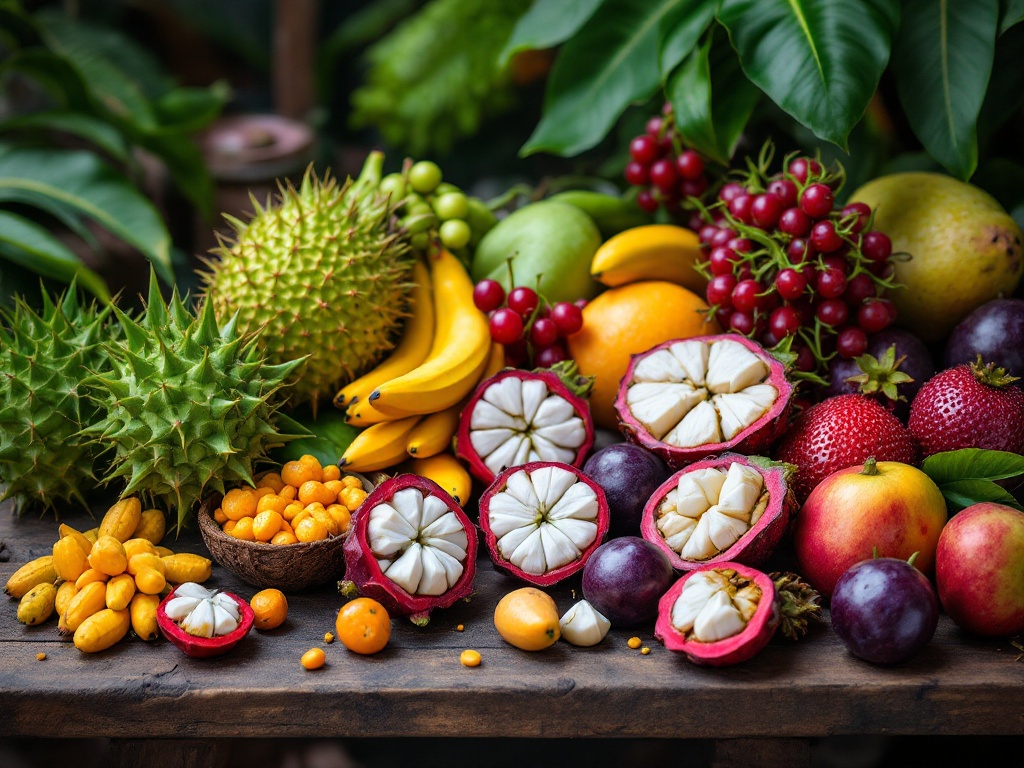Rarest Fruit in the World: What to Try During Your Trip
Embark on a global culinary adventure! Discover exotic fruits like the spiky kiwano, fragrant Buddha’s hand, and the “queen of fruits,” mangosteen. Learn where to find these rare delicacies, from local markets to Southeast Asian travels. Uncover unique flavors and expand your palate. Read on to start your fruity exploration!
Important information

- The mangosteen, dubbed the “queen of fruits,” is known for its sweet and tangy flavor.
- Durian, found in Southeast Asia, has a creamy texture and a pungent aroma.
- Buddha’s hand citron is prized for its fragrant rind, used in cooking and perfumes.
- The rare cloudberry, from Northern Scandinavia, offers a unique tart-sweet flavor.
- Look for rare fruits in local markets, specialty stores, or when traveling abroad.
Rarest Fruits in the World: What to Try During Your Trip
Discover these unique and exotic fruits:
- cherimoya, with its custard-like texture, is a rare and delicious treat.
- akebi offers a special culinary adventure but is a seasonal delicacy.
- buddha’s hand citron, notable for its unusual shape and fragrant zest, is another rare find.
- mangosteen, often called the “queen of fruits,” offers a sweet and tangy flavor.
- rambutan, grown in tropical climates, features a hairy exterior that conceals juicy flesh inside.
To locate these exotic fruits:
- explore local markets and specialty stores.
- consider food tours.
- for a wider selection, travel to Southeast Asia, South America, or various tropical islands.
Exploring Unique Fruit Varieties Across Continents
Embark on a global culinary adventure, discovering surprising flavors and textures of unique fruits.
The African Kiwano, also known as the horned melon, boasts a spiky orange exterior and refreshing, cucumber-like green flesh.
From Asia, the hairy red Rambutan reveals a sweet, white fruit reminiscent of lychees and grapes.
South America’s Jabuticaba, a small, purple-black fruit growing directly on tree trunks, offers a sweet yet slightly acidic taste.
Southeast Asia presents the Mangosteen, hailed as the “Queen of Fruits,” with delicate, sweet, and tangy white segments.
The region also offers the pungent Durian, known for its creamy texture and custard-like flavor.
Asia’s fragrant Buddha’s Hand citron, prized for its rind, is often candied or zested.
Finally, the tart yet sweet golden-orange Cloudberry thrives in Northern Europe. These diverse fruits showcase nature’s creativity, each offering a unique and exciting culinary experience.
Southeast Asia’s Exotic Offerings
Southeast Asia offers a fascinating array of exotic fruits. Durian, with its notorious aroma, is a polarizing delicacy. Mangosteen, known as the “Queen of Fruits,” offers a sweet, tangy taste. The massive jackfruit, the largest tree-borne fruit, has a uniquely starchy texture. Salak, or snake fruit, gets its name from its reddish-brown, scaly skin and offers a sweet, acidic flavor. Other exotic fruits include rambutan, longan, and pomelo.
- Durian: Known for its strong aroma and polarizing taste.
- Mangosteen: Called the “Queen of Fruits” for its sweet and tangy flavor.
- Jackfruit: The largest tree-borne fruit, with a starchy texture.
- Salak (Snake Fruit): Named for its reddish-brown, scaly skin, it offers a sweet, acidic taste.
- Rambutan: Another unique fruit found in Southeast Asia.
- Longan: A small, sweet fruit similar to lychee.
- Pomelo: A large citrus fruit with a thick rind.
Fruits of South America
- Passionfruit, a tangy treat with a sweet edge, comes from the heart of South America.
- The antioxidant-rich jabuticaba grows directly on the tree trunk.
- Açaí berries, celebrated for their health benefits, originate in this vibrant region and have gained immense popularity.
- Lucuma, with its maple-like sweetness, is a beloved addition to desserts and ice cream.
- Pepino dulce, also known as the melon pear, offers a uniquely mild flavor.
Japanese Delicacies
Akebi, a vibrant purple fruit found only in Japan from September to October, is a treasured delicacy. Its slightly bitter flavor lends itself to both sweet and savory dishes. The skin, often stuffed with minced meat or vegetables and then deep-fried or simmered, provides a unique culinary experience. The soft, jelly-like flesh can be enjoyed raw or incorporated into desserts. Beyond its culinary uses, akebi holds cultural significance, symbolizing good fortune and prosperity.
Akebi
A unique, vibrant purple fruit, available only in Japan from September to October. Its slightly bitter flavor complements both sweet and savory dishes.
- Skin: Often stuffed with minced meat or vegetables, then deep-fried or simmered for a unique culinary experience.
- Flesh: Soft and jelly-like, enjoyable raw or in desserts.
- Cultural Significance: Symbolizes good fortune and prosperity.
Other Unique Japanese Fruits
- Square Watermelon: Grown for convenient storage.
- Dekopon: A hybrid citrus fruit known for its sweet juice and distinctive topknot.
These fruits highlight Japan’s appreciation for both novelty and delicious produce.
Legendary Fruits with Cultural Significance
Some fruits transcend their nutritional value and carry deep cultural weight. The Buddha’s Hand citron, prized for its fragrant rind, is a prime example. It symbolizes luck and longevity, playing a key role in Asian cuisine, perfumery, and religious rituals. Similarly, the pomegranate represents prosperity and fertility in certain cultures, while the apple, in biblical lore, embodies both knowledge and temptation. These fruits reveal how deeply intertwined they are with cultural narratives, offering glimpses into our beliefs and enriching human experience.
Mangosteen: The Queen of Fruits
The mangosteen (Garcinia mangostana), native to Southeast Asia, is a tropical fruit cherished for its unique flavor. It offers a delightful blend of sweet, tangy, and subtly acidic notes, reminiscent of lychee and peach. Its white, segmented flesh is not only delicious but also rich in antioxidants, especially xanthones. These compounds are currently being studied for their potential health benefits. This versatile fruit is widely popular in Southeast Asian cuisine, used in desserts, beverages, and even savory dishes.
Durian: Southeast Asia’s Infamous Delight
Native to Southeast Asia, the durian fruit is a culinary enigma. Its large, thorny exterior hides a creamy, custard-like flesh prized by many as a delicacy. While some crown it the “king of fruits,” its pungent aroma, often likened to gym socks or sewage, can be polarizing. The flavor profile is equally complex—a blend of sweet, savory, and creamy notes with hints of almond and cheese. Beyond its unique taste, durian is a nutritional powerhouse, rich in fiber, potassium, and vitamin C. Enjoyed fresh or incorporated into both sweet and savory dishes, it offers travelers an authentic Southeast Asian culinary adventure.
Buddha’s Hand: The Fragrant Fingered Citrus
The Buddha’s hand, resembling outstretched fingers, is a unique citrus fruit prized for its fragrant zest. While it lacks pulp and juice, the rind offers a distinct citrus flavor, often candied or used in marmalades and baked goods. It can even be added to beverages. The remarkable fragrance also makes it a natural air freshener and a component of some perfumes. In some Asian cultures, this symbolic fruit represents luck and prosperity, making it a popular gift during festivals and a common element in religious ceremonies.
Fruits for the Adventurous Palate
The kiwano, also known as the horned melon, sports a vibrant orange rind covered in small spikes. Its inner green flesh has a unique, jelly-like consistency and offers a surprising blend of cucumber, banana, and lime. The salak, or snake fruit, has reddish-brown, scaly skin. Its flesh is sweet and tangy with a pleasant acidic touch.
Jabuticaba: The Tree Trunk Fruit
The jabuticaba fruit, native to Brazil, offers a unique spectacle, growing directly on the tree trunk. Its dark purple skin protects a white pulp with a refreshingly tart flavor. Research suggests this pulp is rich in antioxidants. While often eaten fresh, jabuticaba is also used to make jellies, wines, and liqueurs. Even the skin serves a purpose, sometimes employed as a natural dye.
Norwegian Cloudberries: A Rare Northern Delicacy
Cloudberries, tiny amber gems prized in Northern Scandinavia, ripen in the late summer’s mountainous areas and arctic tundra. Their unique flavor blends the tartness of raspberry and red currant with a delicate floral sweetness. Rich in Vitamin C and antioxidants, these berries have nourished generations. They’ve found their way into jams, juices, and decadent desserts. However, their remote growing locations and brief season make harvesting difficult. Hand-picked one by one, cloudberries are a rare and expensive delicacy.
Creating Your Edible Bucket List
Embark on a culinary adventure and create your own edible bucket list! Start with exotic fruits from faraway lands.
Southeast Asia
- Savor the unique taste of durian.
- Enjoy the sweetness of mangosteen.
- Try the hairy rambutan.
South America
- Indulge in the creamy texture of cherimoya.
- Taste the hybrid fruit atemoya.
- Experience the distinct flavor of cupuaçu.
Japan
- Marvel at the novelty of square watermelon.
- Inhale the fragrance of Buddha’s hand citron.
Unique finds
- Discover the Brazilian jabuticaba, a grape growing directly on the tree trunk.
- Forage for Norwegian cloudberries.
Document your discoveries, capturing the unique tastes, textures, and cultural significance of each fruit. Expand your horizons by exploring local farmers’ markets and specialty food stores, both at home and abroad. Connect with online communities to share tasting notes and uncover hidden fruit gems.
Fruits You Shouldn’t Miss on Your Travels
Embark on a culinary adventure and discover exotic fruits during your travels!
- Savor the pungent durian, known for its creamy texture, primarily found in Southeast Asia.
- Indulge in the “queen of fruits,” the mangosteen, with its sweet and tangy flavor, also native to Southeast Asia.
- Don’t miss the tangy, aromatic burst of passionfruit, grown in tropical and subtropical regions.
Tasting these unique fruits offers a delicious glimpse into different cultures.
How to Source Rare Fruits Locally and Abroad
Discover unique fruits by exploring local farmers’ markets, ethnic grocery stores, and specialty shops. You can also contact local farms directly to inquire about their seasonal offerings. For exotic international fruits, explore online retailers specializing in these options. Be sure to check import rules and quarantine restrictions beforehand. Working with reputable importers can simplify navigating these complex regulations. Remember that peak seasons vary depending on the region and climate, so research the best harvest times to ensure ripe, flavorful fruit. For instance, mangosteen is a summer treat in Southeast Asia, while durian is available from summer to early fall. Don’t forget to explore other seasonal fruits as well.
Discover Unique Fruits Locally
- Explore local farmers’ markets for fresh, seasonal finds.
- Visit ethnic grocery stores for diverse and exciting options.
- Check out specialty shops for rare and hard-to-find fruits.
- Contact local farms directly to learn about their seasonal offerings.
Find Exotic International Fruits
- Explore online retailers specializing in exotic fruits.
- Check import rules and quarantine restrictions beforehand.
- Consider working with reputable importers to simplify navigation of complex import regulations.
Remember that peak seasons vary depending on the region and climate. Research the best harvest times to ensure ripe, flavorful fruit. For example, mangosteen is a summer treat in Southeast Asia, while durian is available from summer to early fall.

















